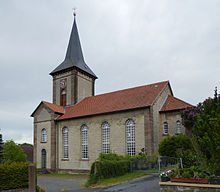Lutterhausen
|
Lutterhausen
City of Hardegsen
|
||
|---|---|---|
| Coordinates: 51 ° 39 ′ 49 ″ N , 9 ° 50 ′ 47 ″ E | ||
| Height : | 211 m | |
| Residents : | 244 (Dec. 31, 2019) | |
| Incorporation : | June 1, 1970 | |
| Postal code : | 37181 | |
| Area code : | 05505 | |
|
Location of Lutterhausen in Lower Saxony |
||
Lutterhausen is a district of the small town Hardegsen in the Northeim district in southern Lower Saxony .
geography
It is located on the southern edge of the Weper at an altitude of 200 to 230 m above sea level. NN and on the B241 , not far from the Solling railway tracks. The closest neighboring town is Thüdinghausen .
history
Already between 780 and 802 the place was attested in writing in the Traditiones et antiquitates Fuldenses , when Nithart and his wife Eggihilt bequeathed their goods to the Fulda monastery in several places, including Luthereshusen . Not far from Lutterhausen was the now desolate village of Heddiehausen. The exact time of its abandonment is unknown, but it probably found its demise before 1479, as the burned-down neighboring towns of Behrensen , Thüdinghausen , Lütgenrode and Hevensen are reported that year, but Heddiehausen is not mentioned. When Hardegsen was besieged in 1466 and the army moved to Moringen , the place possibly went up in flames.
1279 the counts transferred from the castle Lutterberg their tithe to the pin Fredelsloh .
The village was incorporated into the city of Hardegsen on June 1, 1970.
Culture and sights
- The ev.-luth. The church was built in 1852–55 according to designs by the architect and consistorial master builder Ludwig Hellner (1791–1862) in subtle classical forms, but the inauguration took place only after the interior had been finished in 1859. The stone-faced building has one due to its location on the slope above the main road striking effect, which is underlined by the two-storey east facade with a slightly projecting tower in the middle. The wide three-sided gallery and the ceiling structure with a flat ceiling over the side galleries and a flat barrel over the middle creates the impression of a three-aisled church hall. The central nave is extended to the west, there is the pulpit altar wall designed by Landesbauconducteur Bode from Northeim.
- There is a volunteer fire brigade in the village with an attached music train.
- In 1871 - after the German / French war - the carpenter Adolf Hilke built a Hümmelke (fretboard zither) in his father's workshop in Lutterhausen. In Solling there was an older - but isolated - tradition of playing on the Hummel. (Eschershausen since approx. 1815) The Hümmelkes from Solling have a special tradition that there are many sound holes on the instrument side facing the auditorium. The instrument has been in the Northeim Museum since 1920. In 2003 it was restored by W. Ulrich. Sound recordings were made.
economy
The village has two farm shops for sausage and meat, a sheep farm, two dairy farms and a master painter
literature
- Festschrift for the 75th anniversary of the Lutterhausen volunteer fire department (1983)
Web links
Individual evidence
- ↑ Kirstin Casemir, Franziska Menzel, Uwe Ohainski: The place names of the district of Northeim (= Jürgen Udolph [Hrsg.]: Lower Saxony Place Name Book (NOB) . Part V). Publishing house for regional history, Bielefeld 2005, ISBN 3-89534-607-1 , p. 252 .
- ↑ Traditiones et antiquitates Fuldenses , accessed September 5, 2011
- ↑ [1]
- ^ Karl Lechte: History of the city of Hardegsen . Hardegsen 1968, p. 222 .
- ↑ [2]
- ^ Federal Statistical Office (ed.): Historical municipality directory for the Federal Republic of Germany. Name, border and key number changes in municipalities, counties and administrative districts from May 27, 1970 to December 31, 1982 . W. Kohlhammer GmbH, Stuttgart and Mainz 1983, ISBN 3-17-003263-1 , p. 213 .
- ↑ Christian Kämmerer, Peter Ferdinand Lufen: District Northeim, part 1. Southern part with the cities Hardegsen, Moringen, Northeim and Uslar, the spots Bodenfelde and Nörten-Hardenberg, the community Katlenburg-Lindau and the community-free area Solling . Ed .: Christiane Segers-Glocke. CW Niemeyer, Hameln 2002, ISBN 3-8271-8261-1 , p. 122–123 (Monument Topography Federal Republic of Germany. Architectural Monuments in Lower Saxony, Volume 7.1).
- ↑ Wilfried Ulrich: The Hummel: History of a folk music instrument . Ed .: Museumsdorf Cloppenburg. Booklet 42. Museumsdorf Cloppenburg, Cloppenburg 2011, ISBN 978-3-938061-23-7 , p. 33-44 .


